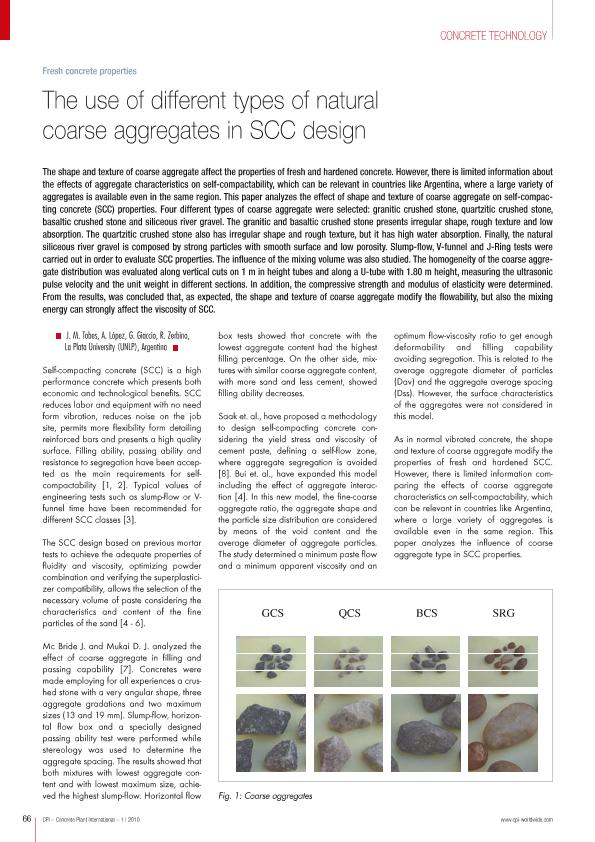Mostrar el registro sencillo del ítem
dc.contributor.author
Tobes, Juan Manuel

dc.contributor.author
Lopez, Anahi

dc.contributor.author
Giaccio, Graciela Marta

dc.contributor.author
Zerbino, Raul Luis

dc.date.available
2023-05-29T17:42:44Z
dc.date.issued
2010-01
dc.identifier.citation
Tobes, Juan Manuel; Lopez, Anahi; Giaccio, Graciela Marta; Zerbino, Raul Luis; The use of different types of natural coarse aggregates in SCC design; ad-media GmbH; PHi-Planta de Hormigón Internacional; 1; 1-2010; 66-71
dc.identifier.issn
1862-0027
dc.identifier.uri
http://hdl.handle.net/11336/198847
dc.description.abstract
The shape and texture of coarse aggregate affect the properties of fresh and hardened concrete. However, there is limited information about the effects of aggregate characteristics on self-compactability, which can be relevant in countries like Argentina, where a large variety of aggregates is available even in the same region. This paper analyzes the effect of shape and texture of coarse aggregate on self-compacting concrete (SCC) properties. Four different types of coarse aggregate were selected: granitic crushed stone, quartzitic crushed stone, basaltic crushed stone and siliceous river gravel. The granitic and basaltic crushed stone presents irregular shape, rough texture and low absorption. The quartzitic crushed stone also has irregular shape and rough texture, but it has high water absorption. Finally, the natural siliceous river gravel is composed by strong particles with smooth surface and low porosity. Slump-flow, V-funnel and J-Ring tests were carried out in order to evaluate SCC properties. The influence of the mixing volume was also studied. The homogeneity of the coarse aggregate distribution was evaluated along vertical cuts on 1 m in height tubes and along a U-tube with 1.80 m height, measuring the ultrasonic pulse velocity and the unit weight in different sections. In addition, the compressive strength and modulus of elasticity were determined. From the results, was concluded that, as expected, the shape and texture of coarse aggregate modify the flowability, but also the mixing energy can strongly affect the viscosity of SCC.
dc.format
application/pdf
dc.language.iso
eng
dc.publisher
ad-media GmbH
dc.rights
info:eu-repo/semantics/openAccess
dc.rights.uri
https://creativecommons.org/licenses/by-nc-sa/2.5/ar/
dc.subject
Self compacting concrete
dc.subject
Coarse aggregates
dc.subject
Mixture design
dc.subject.classification
Ingeniería Civil

dc.subject.classification
Ingeniería Civil

dc.subject.classification
INGENIERÍAS Y TECNOLOGÍAS

dc.title
The use of different types of natural coarse aggregates in SCC design
dc.type
info:eu-repo/semantics/article
dc.type
info:ar-repo/semantics/artículo
dc.type
info:eu-repo/semantics/publishedVersion
dc.date.updated
2023-04-10T10:22:21Z
dc.journal.number
1
dc.journal.pagination
66-71
dc.journal.pais
Alemania

dc.description.fil
Fil: Tobes, Juan Manuel. Provincia de Buenos Aires. Gobernación. Comisión de Investigaciones Científicas. Área Tecnología del Hormigón; Argentina. Consejo Nacional de Investigaciones Científicas y Técnicas; Argentina
dc.description.fil
Fil: Lopez, Anahi. Provincia de Buenos Aires. Gobernación. Comisión de Investigaciones Científicas. Laboratorio de Entrenamiento Multidisciplinario para la Investigación Tecnológica; Argentina. Consejo Nacional de Investigaciones Científicas y Técnicas; Argentina
dc.description.fil
Fil: Giaccio, Graciela Marta. Provincia de Buenos Aires. Gobernación. Comisión de Investigaciones Científicas. Laboratorio de Entrenamiento Multidisciplinario para la Investigación Tecnológica; Argentina
dc.description.fil
Fil: Zerbino, Raul Luis. Consejo Nacional de Investigaciones Científicas y Técnicas; Argentina
dc.journal.title
PHi-Planta de Hormigón Internacional
Archivos asociados
